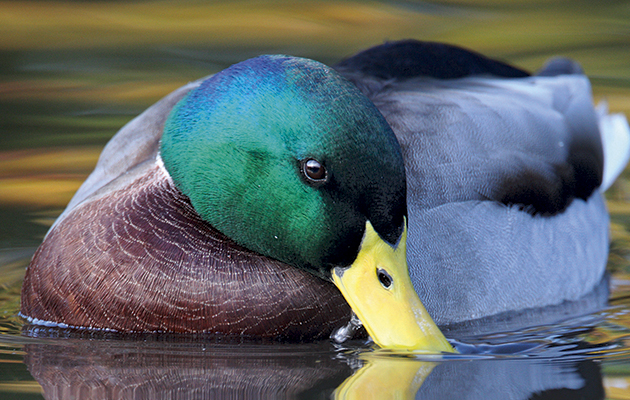Beware the male mallard
The male mallard may be much loved for his colourful plumage but he’s a force to be reckoned with on the duck pond


One of our most common large waterbirds and the ancestor of several domesticated breeds, the mallard is widely regarded as the archetypal wild duck, familiar from the village pond to its ceramic flight over the nation’s mantlepieces.
The name ‘mallard’ (which derives from words for masculinity) used to apply just to the drake of this highly adaptable member of the Anatini tribe of dabbling ducks surface feeders that frequent a broad spread of wetlands and are found virtually worldwide. They voraciously live off plants, grain, crustacea and insects; in the Miocene period, there was even a 10ft-high carnivorous variety.
Handsome in appearance (although Lord Grey of Falloden reckoned them coarse and common), Anas platyrhynchos exhibits pronounced sexual dimorphism: the female is a dowdier brown, but the male sports a glossy, bottle-green head and neck, chestnut breast feathers and distinctively recurved upper-tail coverts that gave rise to the hairstyle known as a DA.
Both sexes have a purple-blue flash, or speculum, on the trailing edge of each wing feathers treasured by fly-dressers for their ‘Butcher’ series and are impressively powerful in flight (a migrating mallard once struck an aeroplane four miles up). The ground waddle is endearing, if not graceful, giving rise to the nice expression ‘drunk as a duck and couldn’t give a quack’.
It’s the more vociferous female that utters the trademark, decrescendo quacking that resembles mocking laughter the male note is softer and he also produces a post-coital whistle. Courtship involves much mutual nod swimming, chin-lifting, uptail posturing and gruntling noises, with actual copulation being brief and on the water.
The male possesses a sizeable external penis (his Argentinian lake cousin has a spiny one some 16in long) and gangs are known to force their attentions on the female, occasionally resulting in her drowning. These ‘farmyard morals’ are said to be rarer in the wild, but one study suggests 60% of all ducklings come from multi-fathered broods.
This reputation for randiness has associated the mallard with followers of Aphrodite and various other fertility cults, although the traditional streetwalker’s term of endearment ‘ducky’ derives from a Dutch word for doll.
Exquisite houses, the beauty of Nature, and how to get the most from your life, straight to your inbox.
The male shirks all familial duties and the nest is constructed by his mate in rough grassland or marsh, although it may be found on forked trees or even urban rooftops. Eight to 10 creamy-green eggs are laid (a cricketer’s zero entry in the scorebook is named for their shape) and the proverbially fluffy ducklings soon take to water a trait appreciated by predators such as pike. If disturbed, the female puts on a histrionic and convincing display of swimming around with a broken wing.
Perhaps to atone for his promiscuity, the drake enters a period of ‘eclipse plumage’ during the summer, moulting his quills and having to skulk flightlessly in the margins. By mid October, he’s restored again to sartorial finery, just as the wildfowling season is getting properly under way. He seldom courts a previous mate again.
Long prized for the pot, mallard have been hunted with hawks, arrows, bolas, snares and baited hooks. At one time, they were harvested using an elaborate netting system known as the decoy: exploiting the ducks’ natural inquisitiveness for land predators, they would be enticed to swim from ponds down gradually constricting netted tunnels often following a trained ‘piper’ dog until the fowler, lurking behind a series of screens, wrung their necks.
Punt guns with barrels up to 10ft long also slew multitudes for the market. In America, ‘decoy’ refers to a carved facsimile waterfowl designed to lure ducks within range of the sportsman; some early examples of this ‘pioneer art’ now change hands for more than half a million dollars.
Selectively bred for the table, the mallard’s descendants include the Pekin (familiar, glazed and golden, from Chinese-restaurant windows), the Mulard (a Muscovy hybrid) and the ponderous white Aylesbury of which Jemima Puddleduck was a prime and gullible example. Excellent roasted and served à l’orange (perhaps with a Malbec), duck is a global delicacy. Ted Nugent, outrageous American rocker and author of Kill It And Grill It, who once claimed to eat vegetarians, declared: ‘My idea of fast food is a mallard.’
From Daffy to Count Duckula, animators and children have long adored the character traits of the duck. Irascible Donald was possibly modelled on the head of Disney’s story department, a George Drake. When an undergraduate, I once played Donald on stage, reincarnated as a camp Broadway impresario, but, down the road at All Souls, once a century, they perform an esoteric college ritual involving a risqué ballad and rowdy procession around the quads to honour a mallard supposedly discovered in the foundations back in the 1440s. They used to decapitate one and drink its blood. At Magdalen, we tended to settle for venison.
Country Life is unlike any other magazine: the only glossy weekly on the newsstand and the only magazine that has been guest-edited by His Majesty The King not once, but twice. It is a celebration of modern rural life and all its diverse joys and pleasures — that was first published in Queen Victoria's Diamond Jubilee year. Our eclectic mixture of witty and informative content — from the most up-to-date property news and commentary and a coveted glimpse inside some of the UK's best houses and gardens, to gardening, the arts and interior design, written by experts in their field — still cannot be found in print or online, anywhere else.
